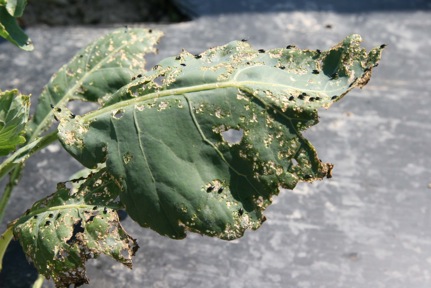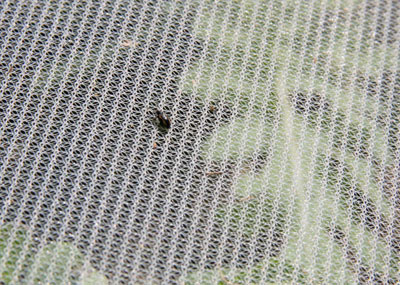
Pests: Crucifer Flea Beetle (Phyllotreta cruciferae) and Striped Flea Beetle (Phyllotreta striolata)
Pest/disease identification and lifecycle, most common symptoms and crops affected:

Crucifer and striped flea beetles feed on brassica crops as well as weeds that are in the same family, such as yellow rocket or wild mustard. Larvae feed on the roots and flea beetle adults feed on leaves and stems, resulting in numerous small holes, or “shot-holes,” feeding on the whole surface of the leaf.
The non-waxy greens (arugula, bok choi, tatsoi, mustard, Chinese cabbage, komatsuna) are preferred to the waxy cabbage, kale and collard types of brassicas.
Waxy crops are most susceptible at the cotyledon and seedling stage and feeding is more limited to leaf margins on older plants. Some crops simply outgrow the beetle pressure and the damage can be tolerated. No damage can be tolerated in leafy greens crops such as arugula.

The crucifer flea beetle is uniformly black and shiny, about 2 millimeters in length, while the striped flea beetle has two yellow stripes on its back. Eggs are laid in the soil starting in late May. The beetles continue feeding from the seedling stage until harvest.
Management options:
Cultural:
To reduce and delay flea beetle invasion of spring crops, move them as far away as possible from the fields that were used for brassica crops last fall. Beetles overwinter in field borders near last year’s crop. Planting the same crop close by to where it was last year ensures a high population in the spring. The same could be true if you have fields full of mustard weeds or move to a field that was seeded to a brassica cover crop the previous year.
Biocontrol:
One of the best ways to protect brassica crops from flea beetles is to place a floating row cover, or exclusion netting, over the bed or row. It is critical to seal the edges immediately after seeding or transplanting, because brassica seeds germinate quickly and beetles rapidly find the cotyledons. Flea beetles can fit through extremely tiny cracks. Edges of the cover must be sealed on all sides using soil, plastic bags filled with soil, or some other method.
Pesticides approved for use in certified organic production (as a last resort):
Spinosad (Entrust is the organic formulation for farmers and Monterey Garden Spray is one for gardeners) is sometimes effective in suppressing flea beetles and reducing damage. Pyrethrin (PyGanic) showed poor to moderate efficacy in trials, and has a short residual period. Yet some growers have reported a good knockdown with this product.
Please note: This information is for educational purposes. Any reference to commercial products, trade or brand names is for information only, and no endorsement or approval is intended. Pesticide registration status, approval for use in organic production and other aspects of labeling may change after the date of this writing. It is always best practice to check on a pesticide’s registration status with your state’s board of pesticide control, and for certified organic commercial producers to update their certification specialist if they are planning to use a material that is not already listed on their organic system plan. The use of any pesticide material, even those approved for use in organic production, carries risk — be sure to read and follow all label instructions. The label is the law. Pesticides labeled for home garden use are often not allowed for use in commercial production unless stated as such on the label.
Informed by: Eric Sideman

